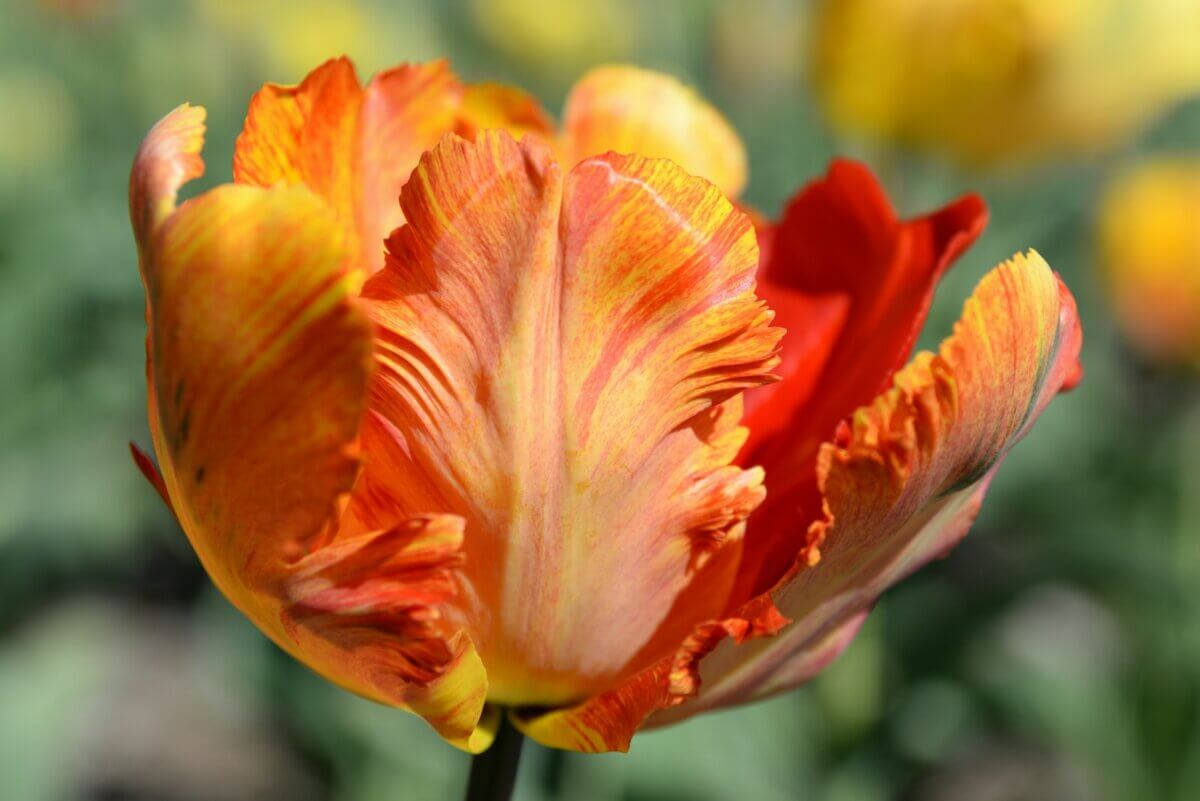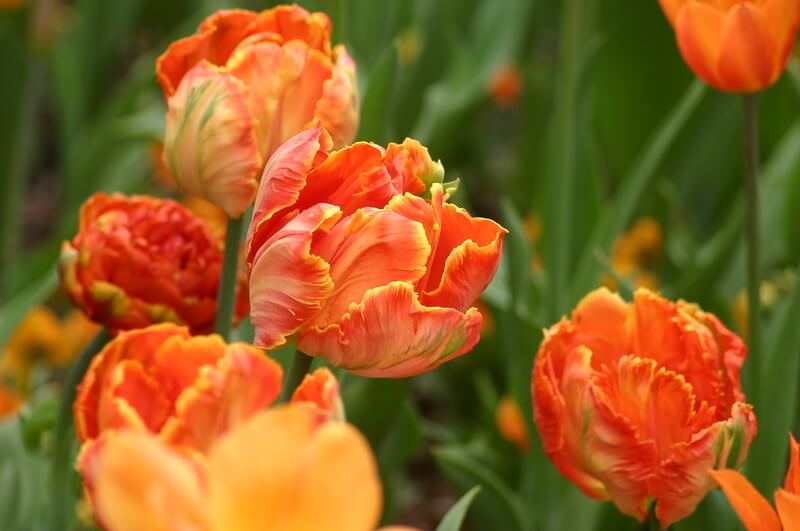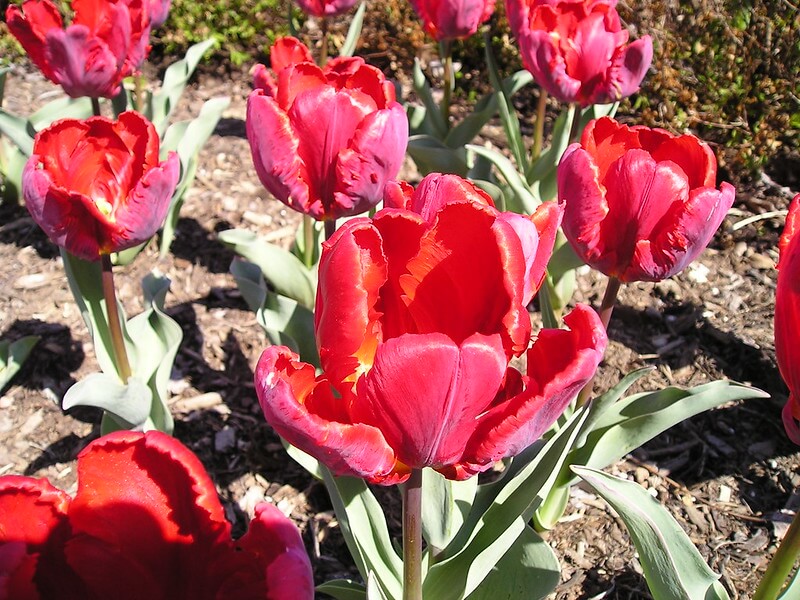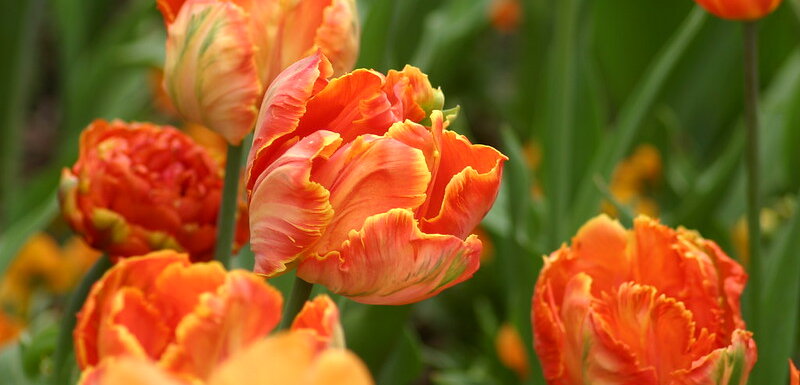“Is something wrong with your tulips?”
It was late spring, and I was admiring the colorful display of tulips in my friend’s garden. “They appear rather ruffled.”
“They’re supposed to be ruffled,” came the answer. “They’re called parrot tulips, and the ruffled edges make them look like a parrot’s feathers.”

“Ruffled,” I repeated.
“Yes. They’re actually a crossbreed; a mutation of late-flowering tulips and tulips from the triumph class.”
“The what class?” I asked. I wasn’t up on the trendiest of flowers. At least, not like my friend.
“Triumph tulips are the largest and most common group of tulips,” she explained. She was forever patient with my endless questions, and did enjoy sharing her vast knowledge. “The cup-shaped flowers come in an endless array of colors, appearing in the garden in mid to late spring. With sturdy stems, these tulips can withstand just about anything.”
“Oh!” I answered. “I do like their ruffled flowers.”
How Parrot Tulips Came to Be
The most common tulip found in spring gardens everywhere is the triumph tulip. It’s colorful, cheerful, tall (some grow to 18 inches), sturdy (they can withstand anything Mother Nature dishes out), and versatile (from spring flower beds, to forced pots indoors, to cut flower arrangements).
There are many cultivars of triumph tulips ranging in size and color. The African queen with its stunning mauve petals that fade to white yellow bases and purple to red on the inside; the early glory, a pretty, pink tulip with a lovely fragrance, and Rembrandt’s favorite: An artist’s delight with its burgundy and white streaks.
Easy to grow and easy to maintain, triumph tulips are definitely favorites. So, it’s not surprising that the triumph tulip has been crossed with other spring flowers to create the equally stunning and unique parrot tulips.
Related Topic: 8 Gorgeous Spring Bulbs To Plant This Fall
Parrot Tulip Appearance
Parrot tulips first appeared in the Netherlands (no surprise there) in the 18th century. These tulips were cherished by the few who could afford to grow them, as they were extremely expensive.

It’s a hardy tulip, with cup-shaped flowers that are fringed, twisted, ruffled, and colorfully splashed with flame-like stripes and feathery markings. The most common colors, are red, violet, yellow, orange, and pink — as well as, believe it or not, green or near black.
These tulips are huge! The flowers measure almost 5 inches across, supported on 15- to 20-inch stems. With long, sturdy stems, parrot tulips make lovely additions to bouquets.
Tulip Symbolism
The tulip (parrot or triumph) is associated with perfect and deep love. As a classic flower that has been around for centuries, the tulip has long been attached to the full meaning of love, whether it’s romantic or family love.
Parrot Tulip Growing Conditions
Like the triumph tulip, parrot tulips grow well in full sun with fertile, well-drained soil. Plant the bulbs in late fall about 5 inches deep with 4 to 6 inches between each bulb. I always plant bulbs, and make sure the ground is firmly packed, then cover it with leaves and make a ring of plastic forks (prongs up) around each planting. This helps prevent chipmunks and squirrels from finding and devouring freshly planted bulbs.

As soon as the spring flowers pop through the frozen ground, I remove the mulch of leaves, as the mulch absorbs the moisture needed by the soil to nurture the bulbs. Water weekly until the flowers fade in the summer.
Some gardeners dig up the bulbs every summer when the flowers are done, and then replant them in the fall. I find if I leave the bulbs planted all summer, it makes it more difficult for chipmunks and squirrels to locate them. Also, the tulip greenery remains for most of the summer adding a luscious background to my other flowers. Even when the greenery turns yellow, it adds color to the garden.
If you do decide to dig up the bulbs, wait until the foliage completely dies. As long as the foliage is green, it’s absorbing much-needed sunlight that supplies food to the bulbs in preparation for the next growing season. Store the bulbs in a warm, dry location until it’s time to replant them in the fall. If the bulbs appear deformed, diseased, or rotted, discard them.
Parrot Tulip Pests
No plant or flower is pest-proof, and the parrot tulip is no exception.
Chipmunks and Squirrels
Chipmunks and squirrels are the most invasive predator of parrot tulips (and all other tulips, for that matter). They dig up the bulbs and eat them, or they re-bury them somewhere else for later consumption. Quite often the re-buried bulbs are forgotten, and you’re left wondering why and how tulips ended up growing in the middle of your lawn.
Prevention Methods
As mentioned, I find the best strategy to divert the attention of these predators is to plant lots of plastic forks, prongs up, around the area the bulbs are planted. Also, pack the dirt down firmly and cover with a thick layer of leaves or natural mulch. If you leave the bulbs in the ground over the summer, it’s less likely for chipmunks and squirrels to find the bulbs (as the ground becomes packed). I still leave the forks in place. The thick foliage of flowers during the growing season quickly covers them.
Deer, Rabbits, and Voles
Since tulips grow tall, and are brightly colored, which makes them attractive to herbivores, they’re prime food on the menu in the spring when the flowers are in full bloom. You’ll know you have a problem if the leaves are ragged, the stems broken, or the flower petals are shredded.
Prevention Methods
You can erect perimeter fencing around your tulips (about 6 feet tall) to deter these herbivores. There are some attractive garden fencings that would do very well. Alternately, you can be more aggressive and install chicken wire or wire mesh around your tulip garden — not as attractive, but it works. Some people lay bubble plastic around the base of their tulips. When animals step on the plastic and the bubbles burst, the noise spooks them. It’s an interesting scare tactic, but since plastic isn’t environmentally friendly, I’m not sure it’s a tactic I’d want to use. A pair of old, stinky shoes also deters these herbivores. It can be hidden, like the plastic forks, amongst the foliage. Using strong odorous substances, like garlic, black pepper, or ammonia is a good deterrent. This can get costly, especially since you have to reapply after every rainfall. Another option is to cover the plants with containers or a tarp at night which is when these herbivores devour the gardens. However, this might be an overwhelming task if your tulip garden is as large as mine.
Insects
And then there’s the insect dilemma. A gardener is never totally free of an insect infestation. Even parrot tulips suffer from aphids, spider mites, caterpillars, snails, thrips, and slugs.
Prevention Methods
While horticultural soaps may be helpful, sometimes it’s a matter of pulling off the invasive bug, like the caterpillars, snails, thrips, and slugs, and squishing them individually. Not a job for those squeamish. Bulb flies and bulb mites are another issue of concern. The only way to eradicate that problem is to dig up the bulb and discard it (not compost it as it’ll reinfest the soil). Leaving infected bulbs near uninfected bulbs raises the risk of the problem spreading.
Culinary Uses of Parrot Tulips
Tulip bulbs are edible. In fact, during the Second World War, people in Holland dug up their tulip bulbs and ate them. Cooked, the bulbs taste like onions, and they can be used as a substitute in soup or stew. Fresh bulbs crushed, make a fine powder that can be used as a replacement for flour or cereals like porridge.
Tulip flowers are also edible, often used to make wine.
Medicinal Uses of Parrot Tulips
Among many other ingredients, tulip flowers are full of natural humectants that retain water. The petals are used for skin care. They can make the skin glow and appear youthful all year long.
The flowers also make a good poultice for insect bites and bee stings, and they provide relief from skin irritations. But like anything else, some people will experience an allergic reaction to the medicinal use of tulip flowers.
Tulip sap is used as a diuretic and its antiseptic properties make it a good treatment for coughs and colds.
In fact, parrot tulips are very much like other triumph tulips in their care and practical uses. What sets them apart is the pretty, ruffled petals that provide a unique addition to any garden space.










































They would be a beautiful, thick display in window or patio boxes which would keep them safe from deer and pests; besides, providing a close, glamorous display for our enjoyment.